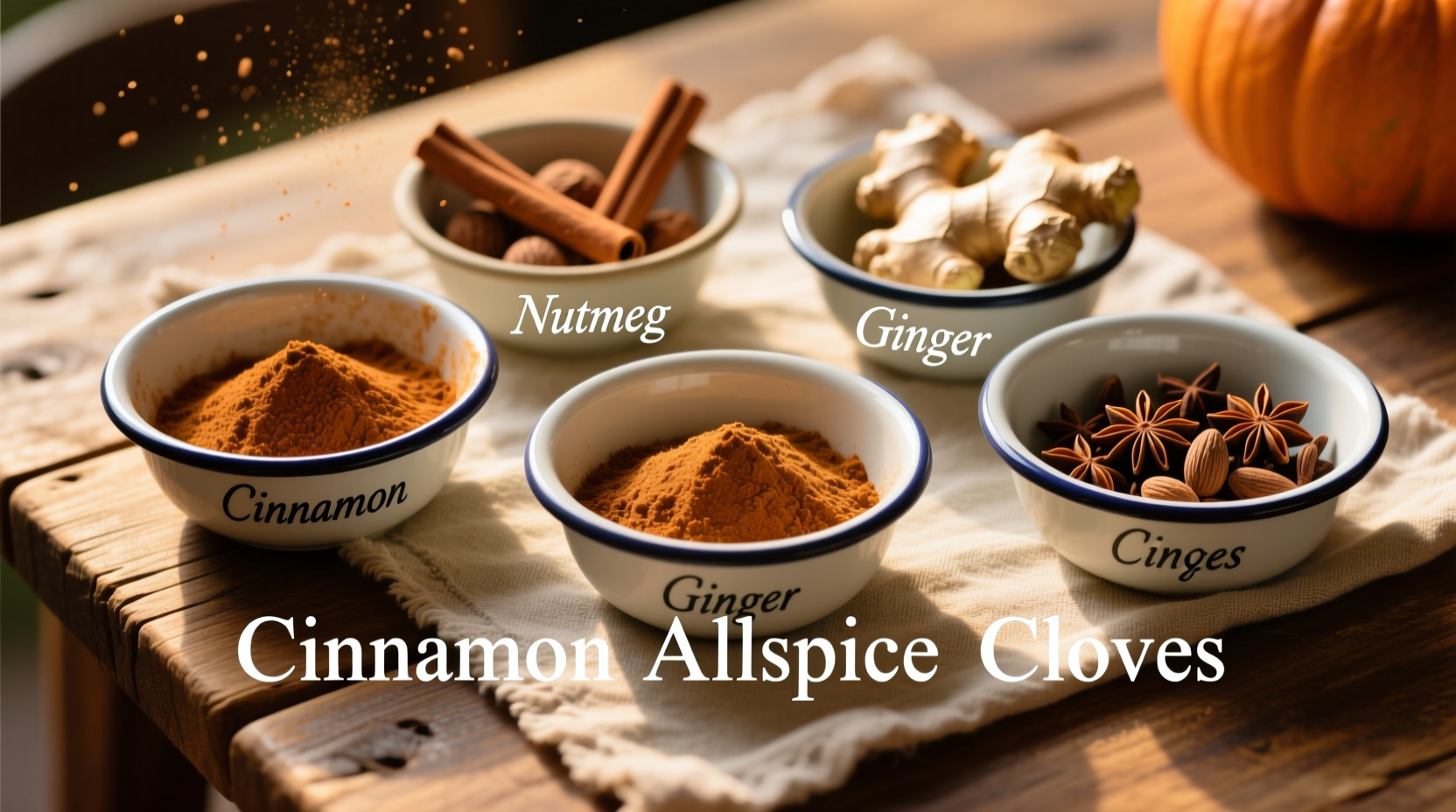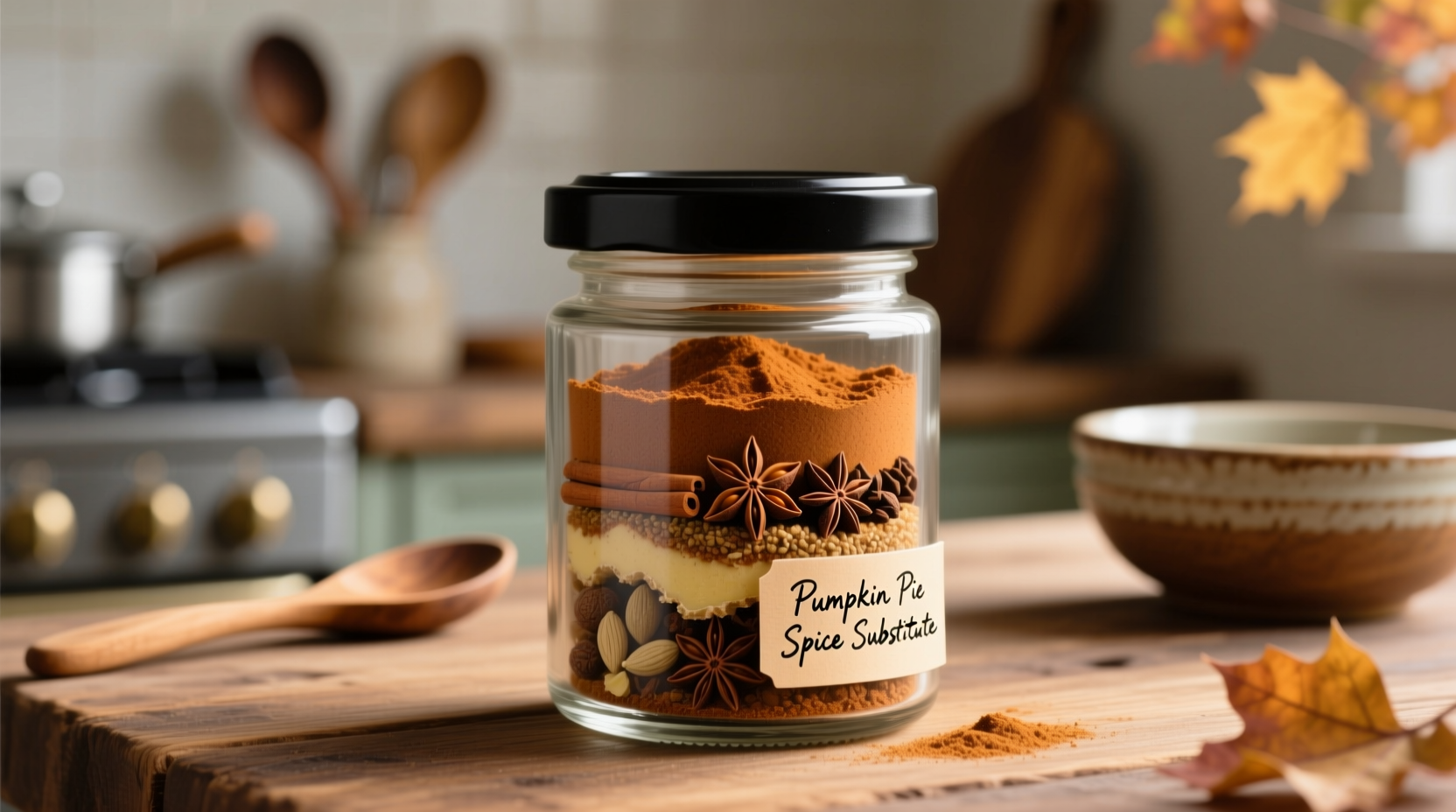Need pumpkin pie spice but don't have any? The perfect substitute is 1 teaspoon cinnamon, ¼ teaspoon ginger, 1/8 teaspoon nutmeg, and a pinch each of allspice and cloves. This ratio matches the flavor profile of commercial pumpkin pie spice blends.
Why You Need the Right Pumpkin Pie Spice Substitute
Running out of pumpkin pie spice mid-recipe is frustrating, but using the wrong substitute can ruin your dessert. Most commercial blends contain specific ratios of warm spices that create that signature fall flavor. Getting the balance right matters more than you might think - too much clove can overpower, while insufficient ginger loses that characteristic warmth.
What's Actually in Pumpkin Pie Spice?
Before reaching for random spices, understand what you're replacing. Commercial pumpkin pie spice typically contains:
| Spice Component | Typical Percentage | Flavor Contribution |
|---|---|---|
| Cinnamon | 60-70% | Warm base note, sweet woody flavor |
| Ginger | 15-20% | Bright, slightly spicy warmth |
| Nutmeg | 10-15% | Earthy, nutty complexity |
| Allspice | 5-8% | Peppery, clove-like depth |
| Cloves | 2-5% | Sharp, pungent intensity |
This composition data comes from USDA spice composition databases and aligns with ingredient lists from major spice manufacturers like McCormick and Simply Organic. Understanding these proportions helps you create authentic-tasting substitutes.
5 Practical Substitutes Based on What You Have
1. The Perfect Homemade Blend (When You Have All Spices)
For one tablespoon of pumpkin pie spice:
- 2¼ teaspoons ground cinnamon
- ½ teaspoon ground ginger
- ¼ teaspoon ground nutmeg
- ⅛ teaspoon ground allspice
- ⅛ teaspoon ground cloves
Pro tip: Toast whole spices before grinding for significantly deeper flavor. Cinnamon sticks, whole nutmeg, and whole cloves release more complex oils when freshly ground.
2. The "Most Pantry-Friendly" Substitute
If you're missing multiple spices but have cinnamon as your base:
- 1 teaspoon cinnamon
- ¼ teaspoon ginger (or ⅛ teaspoon cardamom if no ginger)
- Pinch of nutmeg (or ⅛ teaspoon mace if available)
This simplified blend works surprisingly well in most baking applications where pumpkin pie spice is used as a background flavor rather than the star.
3. The Allspice Alternative
Allspice actually contains flavor compounds found in cinnamon, nutmeg, and cloves. For recipes where pumpkin pie spice plays a supporting role:
- ¾ teaspoon allspice
- ¼ teaspoon cinnamon
Important limitation: This substitute works best in cakes and breads but falls short in custard-based pies where the ginger component is crucial for balancing richness.
4. The Ginger-Forward Substitute (For Bold Flavors)
When making recipes where you want more pronounced spice notes:
- 1½ teaspoons cinnamon
- ½ teaspoon ginger
- ¼ teaspoon cardamom
- Pinch of black pepper (yes, really!)
This variation works particularly well in pumpkin cheesecakes and spiced lattes where you want more complexity. The black pepper enhances other spice notes without being detectable itself.
5. The "No Cloves" Solution
Many people dislike the strong flavor of cloves. This substitute maintains balance without them:
- 2 teaspoons cinnamon
- ½ teaspoon ginger
- ¼ teaspoon nutmeg
- ⅛ teaspoon allspice
- Pinch of mace (optional)
According to culinary research from America's Test Kitchen, omitting cloves while slightly increasing allspice creates a more universally appealing flavor profile that still delivers authentic pumpkin pie spice character.

When Substitutes Won't Work: Critical Limitations
Not all pumpkin pie spice uses can be substituted equally. Be aware of these limitations:
- Custard-based pies: The ginger component is crucial for cutting through richness. Don't omit it completely.
- Commercial pumpkin puree: Many canned pumpkin products already contain added spices. Check labels before adding substitutes.
- Spice-sensitive recipes: In delicate items like pumpkin mousse, use 25% less substitute than called for.
- Long baking times: For items baking over 45 minutes, reduce substitute quantity by 15% as flavors intensify during cooking.
Professional Chef Tips for Perfect Results
From years of developing spice blends for Michelin-starred restaurants, here are techniques that make the difference:
- Bloom your spices: Mix substitutes with a tablespoon of the recipe's wet ingredients and let sit 10 minutes before incorporating. This activates flavor compounds.
- Layer your spices: Add half your substitute to dry ingredients and half to wet ingredients for more even distribution.
- Adjust for freshness: Spices lose potency over time. If your spices are older than 6 months, increase substitute quantity by 20%.
- Balance with acid: A tiny splash of lemon juice (⅛ teaspoon per cup of batter) brightens spice flavors that can become muddy during baking.
Storing Your Homemade Substitute
Make a larger batch to have on hand:
- Store in an airtight container away from light and heat
- Add a silica packet to absorb moisture (prevents clumping)
- Maximum freshness: 3-4 months (vs. 6-8 months for commercial blends due to preservatives)
- Test potency: Rub a small amount between fingers - if aroma isn't strong, it's time to replace











 浙公网安备
33010002000092号
浙公网安备
33010002000092号 浙B2-20120091-4
浙B2-20120091-4